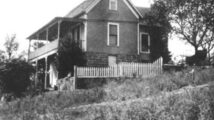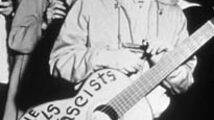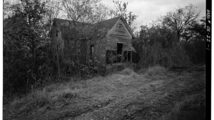About Woody Guthrie
Woodrow Wilson "Woody" Guthrie (1912-1967)
Woody Guthrie is the original folk hero. It was Guthrie who, in the Thirties and Forties, transformed the folk ballad into a vehicle for social protest and observation. In so doing, he paved the way for Bob Dylan, Bruce Springsteen, and a host of other folk and rock songwriters who have been moved by conscience to share experiences and voice opinions in a forthright manner. Guthrie wrote hundreds of songs, including such revered classics as “This Land Is Your Land,” “So Long, It’s Been Good to Know You,” “Grand Coulee Dam,” “I Ain’t Got No Home” and “Dust Bowl Refugees.” The colorful life he led became as legendary as the songs he wrote. Fueled by wanderlust, Guthrie hit the road during the Depression, hitchhiking and riding the rails across the Midwest and Far West. From those experiences came source material for his songs and a lifelong commitment to radical politics.
Woodrow Wilson Guthrie was born on July 14, 1912, in Okemah, Oklahoma. His father was a real-estate broker who fell on hard times, and his mother suffered from Huntington’s chorea, a genetic nerve disorder that led to her death in a state mental hospital. Guthrie grew up an eccentric loner, always on the go, fueled by an impetuous creative drive and a boundless curiosity about the world.
In his adolescence, Guthrie learned how to play guitar, mandolin, fiddle and harmonica. He also read and wrote voraciously, drew cartoons and painted. He never cared much about money, and he would do almost anything, from sign painting to street singing, to avoid the tedium of a regular job. He spent the first 20 years of his life hanging around Okemah and, later, Pampa, Texas, where his family moved. He made his first semi-professional music with the Corncob Trio, playing old-time country songs by the Carter Family and Jimmie Rodgers.
During the Great Depression, Guthrie hit the road, hitchhiking and riding the rails across the West and Midwest, singing old songs to migrants and hobos. He slept on the ground, went hungry and was rousted by cops. These experiences fueled his songs and stories (as well as an autobiography, Bound for Glory). By decade’s end, his populist convictions led him to embrace communism, although he was denied membership in the Communist Party because he refused to renounce religion.
In 1933, Guthrie married Mary Jennings in Pampa. They had three children, but his constant traveling caused them to get a divorce. In 1934, he published his first book of original songs. Two years later, he left Pampa for good and headed to Los Angeles, where he hosted a radio show on KFVD for a dollar a day.
Then, in 1940, he headed to New York, where he met the Weavers and Pete Seeger. Guthrie took the city’s left-wing community by storm. He performed on network radio, wrote a column for the Communist newspaper The People’s Daily Worker, played at strikes and rallies and recorded prolifically for the Folkways label. All the while, the self-taught folksinger studied politics, economics, science and religion.
Although his left-wing leanings did not endear him to the U.S. government, his anti-Hitler songs did. His guitar had a sign on it, saying, “This Machine Kills Fascists.” From 1943 to 1945, Guthrie was with the U.S. merchant marines in the United Kingdom, Italy and Africa. In 1945, he married again, this time to Marjorie Greenblatt Mazia. They had four children, including Arlo, who would go on to his own career in music.
By this point, Guthrie was beginning to suffer bouts of depression. In 1952, he was diagnosed as an alcoholic and confined to a mental institution. Then his problem was correctly identified as Huntington’s chorea, the same genetically transmitted degenerative disorder of the nervous system that had killed his mother. The disease kept him inactive and hospitalized for most of the last decade of his life.
The years leading up to his death on October 3, 1967, were characterized by painful separations from his family, desperate attempts to write and bedside visits from youthful admirers like Dylan. Nonetheless, his fame continued to grow, as more songwriters and musicians became familiar with his work. At the time of his death, his body of work included roughly 1,000 songs.
In 1964, Pete Seeger wrote: “I think that, of Woody’s thousands of songs and verses, quite a large number are going to outlive this century, and this is a rare thing for a songwriter. ...I think maybe several dozen of Woody’s songs are going to be sung by my grandchildren and their grandchildren. What better kind of immortality could a man have?”
And, indeed, Woody Guthrie’s songs have continued to live on, and his music continues to inspire artists and writers, including people like John Mellencamp, Billy Bragg and Jeff Tweedy. There have also been many tributes to Guthrie over the last several decades. Seeger organized a series of memorial concerts in the late Sixties. In 1996, the Rock and Roll Hall of Fame and Museum honored Guthrie with the American Music Masters tribute.
There have also been numerous reissues of his work, the most recent one being the Smithsonian Folkways set Woody at 100: The Woody Guthrie Centennial Collection.
Woody Guthrie was inducted into the Rock and Roll Hall of Fame in 1988. In 2000, he received a Grammy Lifetime Achievement Award. In 2013, the Woody Guthrie Center, home to the Woody Guthrie archives, opened in Tulsa, OK.
- biography taken from the Rock and Roll Hall of Fame
















